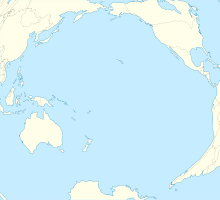Wake Island Airfield
| Wake Island Airfield | |||||||||||
|---|---|---|---|---|---|---|---|---|---|---|---|
| Summary | |||||||||||
| Airport type | Military | ||||||||||
| Operator | U.S. Air Force | ||||||||||
| Location | Wake Island | ||||||||||
| Elevation AMSL | 23 ft / 7 m | ||||||||||
| Coordinates | 19°16′57″N 166°38′12″E / 19.28250°N 166.63667°ECoordinates: 19°16′57″N 166°38′12″E / 19.28250°N 166.63667°E | ||||||||||
| Maps | |||||||||||
 Runway on Wake Island |
|||||||||||
| Location in the Pacific Ocean | |||||||||||
| Runways | |||||||||||
|
|||||||||||
|
Source: Federal Aviation Administration
|
|||||||||||
Wake Island Airfield (IATA: AWK, ICAO: PWAK) is a military airport located on Wake Island, which is known for the Battle of Wake Island during World War II. It is owned by the U.S. Air Force and operated by the 611th Air Support Group. The airfield primarily serves military flight activity within the Wake Island region; however, military presence is minimal at the current time. The runway can be used for emergency landings by commercial jetliners flying transpacific routes.
The first intention to build an air base surfaced in 1935, when Pan American World Airways (PAA) selected Wake Island as an intermediate support base for their seaplane routes to the Far East, especially the Philippines. A year prior, jurisdiction over Wake Island was passed to the Navy Department, which cooperated with PAA in updating topographical surveys, due to the potential military value of having a suitable air base relatively near the USSR eastern border.
Between 5 and 29 May 1935, Pan American's air base construction vessel, North Haven, landed supplies and equipment on Wilkes Island for eventual rehandling to Peale Island which, because of its more suitable soil and geology, had been selected as site for the PAA seaplane base. By the time of North Haven's return to Wake, after a month's voyage westward to Manila, the project was well under way and, three months later on 9 August 1935, a Pan American Sikorsky S-42 flying boat made the first aerial landing at the atoll.
From 1935 until 1940, when two typhoons swept Wake with resultant extensive damage to the now elaborately developed Pan American facilities, development and use of the base were steady but uneventful. A hotel was built, farm animals imported, and hydroponic truck farming commenced. The seaplane base on Peale Island was too limited to support realistic military activity on the atoll, thus supporting plans for development of a full-scale military air base with runway for land based aircraft.
...
Wikipedia

